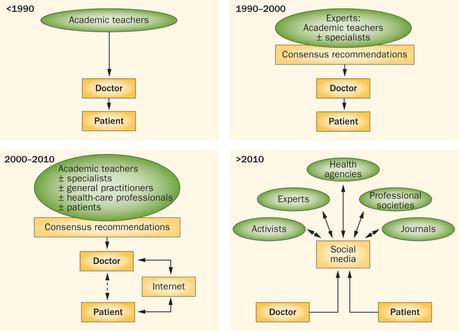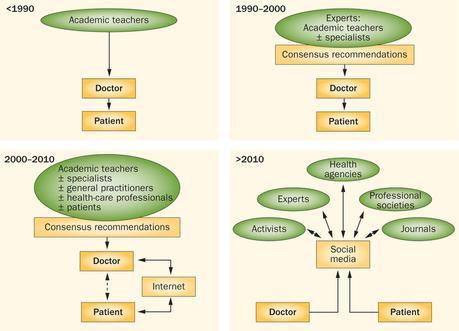

As an experiment, I immersed myself in social media for the past three months. I started this blog, joined Twitter, LinkedIn, Google+, bought a domain name, and posted on Facebook for the first time in years. Even within this short period of time, I reaped tangible benefits: I interacted with top physicians from across the world, kept up with the medical literature, participated in discussions with patients about how how rheumatic diseases affect their lives, joined webinars about improving the patient experience, and provided educational information to physicians and patients about autoinflammatory diseases, my clinical interest. Social media has changed the way that I think about and practice medicine, and it's only been a few months.
I presented the results of my experiment in social media as a Rheumatology Grand Rounds lecture at my hospital. I argued that leveraging social media will make us better physicians. Some in the audience were skeptical, others asked me for a written guide on how to start. This is that guide.
This post is the first of a series about how physicians should use social media. In it, I will review a brief history of social media, and will start by describing how I've used Twitter to educate myself and others about rheumatologic conditions. Future posts will discuss other social media platforms, such as blogs, Facebook, LinkedIn, Doximity, and the importance of the "online reputation."
After reading this guide, I suggest that you conduct your own experiment in social media, just like I did, and let me know what you think...Godspeed!
Reprinted by permission from Macmillan Publishers Ltd. Nature Reviews Rheumatology, 2014.
The last few years has brought about a marked change in the way that medical information is disseminated [1]. Thirty years ago, a few academic physicians (who literally wrote the books on medicine) informed other doctors how to practice. Doctors, in turn, educated their patients about their medical conditions. Over the last ten years, this hierarchical system has changed drastically. First, with the development of the internet, both physicians and patients had access to reliable information about health and disease, with the caveat that the information was static and not easily updated. Web 2.0 and social media changed all that.
According to Dr. Berenbaum (@Larhumato), social media is defined as virtual communities "that allow for interactions among people in which they create, share, and exchange information and ideas" [1]. Over the last five years, doctors, patients, medical journals, hospitals, professional societies, and patient advocacy groups have immersed themselves in social media. Unlike the old internet, users of social media are encouraged to create content and add value to these communities.
The majority of the US population uses social media on a regular basis. According to a study by the Pew Research Center, the use of social media continues to increase every year for people of all ages [2]. As of 2013, 90% of those ages 18-29 use social media on a regular basis. It is also increasing for older demographics, as shown in the graph above.
Across the world, there are over one billion people using Facebook, as well as half a billion usingTwitter, two of the most popular social media platforms [3].
Patients have immersed themselves online as well. According to another Pew Research Center study, 72% of internet users reported looking for health information online within the past year [4]. Hospitals have also taken the dive into social media. Although only 25% of hospitals are involved in social media [5], this appears to be increasing exponentially. Physicians have also increased their involvement in social media, as shown in this amazing video.
So why would you want to be involved with social media? Well, to paraphrase the bank robber Willy Sutton: "because that's where your patients/colleagues/researchers/journals/information/ organizations/conferences are!"
TWITTER:
Let's begin with Twitter. Twitter is a micro-blogging platform, where messages are limited to 140 characters. Messages can be text, links, images, or videos. This brevity, although intimidating at first, actually promotes rapid discussions, and allows you to easily use Twitter from a mobile device.
Your first step is to create your Twitter username. You should try to have your username be similar to your real name. However, since your name may already be taken by a doppelganger, you may need to be creative and add additional letters such as "Dr," or "MD," or anything else you'd like. Mine is @HausmannMD.
Second, you decide whom you want to follow. This can include presidents such as @BarackObama, physicians such as @Atul_Gawande, medial journals such as @NEJM, as well as medical organizations like @AmerMedicalAssn. Almost anyone who has something interesting to say is already saying it on Twitter, and by not being there, you're missing out.
If you want to use Twitter to become a better doctor, choosing the right people to follow is most important. You should follow any physicians you admire. Follow your colleagues. Follow friends that have interesting things to say. Follow your specialty medical organization, favorite journals. For rheumatologists, a great place to start is by following these physicians as well their list of Twitter rheumatologists that they have complied (@RonanTKavanagh has a list here, @carvicab has a list here, @psufka has a list here, and @NatRevRheumatol has a list here). For other specialties, just Google "twitter list" and the specialty you're interested in following, and then follow those physicians. Want to follow more physicians in other specialties? Here is list of 765 physicians of all make and models who use Twitter, compiled by @JBBC.
When you follow somebody, you will see all the messages that they send. If you post interesting material, then others will want to follow you too. Because anybody will be able to follow you, and anybody will be able to read your tweets, you should be careful what you write (in fact, this is true about anything you write online, which will be visible to anyone until the end of time, or the end of the internet, whatever comes first!).
Your Twitter homepage will then show your customized stream of messages from the people that you follow. It will be continuously updating, 24 hours a day, 7 days a week. When I first used it, I was overwhelmed, as I tried to keep up with all of the messages that had been posted since I last logged in. However, I quickly learned that the purpose of Twitter is not to read every message that everyone sends at all times, but just to get a sense of what people are talking about at the time you're checking your Twitter stream. Twitter should be used like a dog uses a window during a car ride-sometimes he likes to stick his head out to see what's going on outside, but most of the time, he's happy being warm and safe inside the car.
Now that you've begun to follow people on Twitter, you're wondering: "What's it good for? What can Twitter do for me?" Well, let me tell you what I've gained from it over the last few months. I used Twitter to ask other physicians questions about patient care, and quickly received answers from experts across the globe. I began friendships with physician leaders, some of whom I never would have had the opportunity to meet. I learned from patients things about their diseases that are not written in any textbook: how the disease affects their daily lives, what they wished they could change about their doctor or the care they received. I also educated patients and physicians about topics in rheumatology, and was able to provide guidance to some patients who didn't know where to start. I also used Twitter to direct people to my blog, when appropriate (is this how you found me?).
In addition, Twitter is an efficient and exciting way to keep up with the medical literature. Instead of browsing all the journals in your specialty to find articles that are relevant to you, why not delegate that task to the people you are following? In Twitter, all the links to articles are, in essence, "curated" by the person who sent it. The wonderful thing about Twitter is that most users are actively engaged in reading and sharing articles they think you will find relevant. Thus, it's a great way to find articles that people in your field are talking about. Likewise, if you stumble into a great article, Twitter makes it easy to share that content with others.
Some doctors are even using Twitter to conduct informal research. You can also take part in Tweet chats about various medical topics (Symplur has a list of sessions here), as well as attend webinars on a variety of different medical topics, and using Twitter to discuss the presentations with other webinar attendees. I highly recommend Stanford MedicineX, often hosted by @hurtBlogger (an ePatient advisor and rheumatology patient), which holds weekly webinars and Tweet chats on emerging technology and medicine.
But Twitter is about more than just medicine. It has connected me to the world. Thankfully, not all of the articles shared by physicians are necessarily about medicine. Over the last few months, physicians have shared articles about the economy, the situation in Venezuela, big data, intelligence, mindfulness meditation, and empathy. I received recommendations for fiction books to read, music videos to watch, as well as suggestions about where to eat and what shows to see. Physicians often share videos, some of which are truly touching, others had me rolling on the ground with joy and laughter. Twitter has increased both the depth and breadth of my readings, and I think it has made me, not only a better doctor, but a better person.
Sourced through Scoop.it from: autoinflammatorydiseases.org
enfin un article de fond +++
See on Scoop.it - e-Pharma & Social Media
